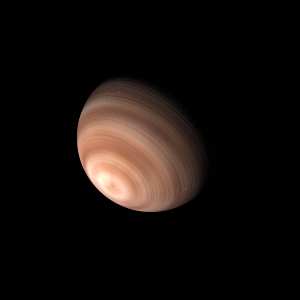|
|
Space Astro
|
Info for exoplanet "Pomely-cisco"
| Scientific (actual) data |
|---|
| Name | HD 1502 b |
| Planet status | Confirmed |
| Mass sini | 2.75 |
| Radius | 1.183 |
| Orbital period | 428.5 |
| Semi major axis | 1.262 |
| Orbit eccentricity | 0.031 |
| Angular distance | 0.008239 |
| Discovered | 2011 |
| Updated | 2018-12-30 |
| Omega | 126 |
| Tperi | 2455170 |
| K | 57.5 |
| Publication | Published in a refereed paper |
| Detection type | Radial Velocity |
| Mass measurement type | Radial Velocity |
| Radius measurement type | Theoretical |
| Star name | HD 1502 |
| Right ascension | 4.82° |
| Declination | 14.05° |
| Mag v | 8.36 |
| Star distance | 159 |
| Star metallicity | 0.09 |
| Star mass | 1.46 |
| Star radius | 4.67 |
| Star sp type | K0D |
| Star age | 2.4 |
| Star temperature | 4947 |
| Wikipedia article | HD 1502 b |
Back
| |
| Fictional info (?) |
|---|
| Suggested name | Pomely-cisco |
| Planet type | Cold planet |
| When viewed from Earth, this proximity to HD 1502 means the planet can only be seen near the western or eastern horizon during the early evening or early morning.
As seen from HD 1502, in a frame of reference that rotates with the orbital motion, it appears to rotate only once every two years.
Having almost no atmosphere to retain heat, it has surface temperatures that vary diurnally more than on any other planet in its solar system, ranging from 105°K (-168°C) at night to 910°K (637°C) during the day across the equatorial regions.
It has the densest atmosphere of the three cold planets, consisting mostly of hydrogen chloride.
Because of its fast rotation, the planet's shape is that of an oblate spheroid (it has a slight but noticeable bulge around the equator). |
| Atmosphere | Hydrogen chloride | 78% |
| 2H2O | 12% |
| Oxygen | 6.7% |
| Argon | 2.7% |
| Hydrogen peroxide | 0.47% |
| Molecular hydrogen | 0.0044% |
| Neon | 5.0E-6% |
| Atmospheric pressure | 0.12 bar |
 |
| No known satellites |
| Google search for Pomely-cisco |
|
Website by Joachim Michaelis
|
|
|
|